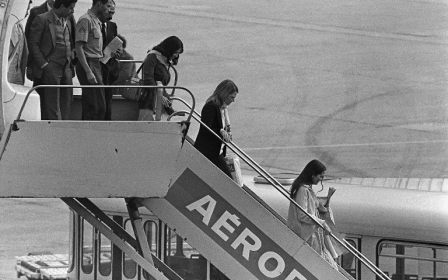By seizing US sailors, Iran's guards send message home and to the West

The seizure and swift release of 10 US sailors travelling in two navy boats speaks to continuing tense relationship between Iran and the US in the region. The incident occurred against a backdrop of escalating tensions between Iran and Saudi Arabia, thus underlining the potential volatility of the military balance in the Gulf.
Much of the analysis has focused on the nuclear-related Joint Comprehensive Plan of Action (JCPOA), which has just begun in earnest, and the prospect of the immediate lifting of sanctions. The conventional wisdom appears to be that the Iranians avoided making a fuss of the issue, by for instance detaining the US sailors for longer, in order to not jeopardise the nuclear deal.
In fact the significance of this incident goes beyond the JCPOA and can be analysed and interpreted at military, strategic, diplomatic and political levels. The violation of Iranian territorial waters notwithstanding, it is important to note at the outset that the incident was instigated, managed and concluded by the Islamic Revolutionary Guards Corps (IRGC).
In strict military terms the incident is not overly important. The United States and Iran regularly test each other in the Gulf, in order to probe boundaries, measure reaction and to collect intelligence.
Whilst the US does not frequently violate Iranian territorial waters, the fact is violations do occur (often intentionally) and they do not necessarily always elicit a forceful reaction by the IRGC navy.
The key in this episode is timing, with the nuclear deal entering implementation phase and the concomitant perceived softening of Iran’s attitude to the United States, the IRGC feels the need to project strength. It is noteworthy that barely a few weeks ago the IRGC navy allegedly conducted a live fire exercise close to an American aircraft carrier in the Strait of Hormuz.
None of this should be interpreted as preparation for a potential military clash with the US navy in the Persian Gulf. Iranian military doctrine in this arena is foremost shaped by the painful experience of 18 April, 1988, during US operation Praying Mantis, when in the space of a single day US forces in the Gulf destroyed a quarter of the Iranian navy.
In the strategic sphere, the massive disparity in naval assets between the two powers informs the IRGC’s behaviour toward US forces in the region.
Since the ending of the Iran-Iraq War in August 1988, the IRGC navy, which controls Iranian naval strategy at the most forward positions in the Gulf, has innovated and seemingly perfected a wide range of methods designed to successfully challenge US naval supremacy short of triggering a shooting war.
The intended effect is to assert a forceful Iranian naval posture that is more than capable of filling the security and strategic vacuum once the US navy finally departs the Persian Gulf arena.
Thus in strategic terms the IRGC has its sights on the very long term and all of its kinetic engagements with US naval assets in the Gulf are designed to meet this objective, namely to accelerate the eventual US withdrawal from the region. From the IRGC point of view, every carefully crafted move, no matter how insignificant it may appear, counts in the long term.
In the diplomatic arena the IRGC is locked in rivalry with the administration of President Hassan Rouhani for control over regional policy. JCPOA is important in this context, and whilst the IRGC is not opposed to the the deal in principle, the Revolutionary Guards in tandem with most of the Iranian establishment prefer minimal compliance with the terms of the agreement.
Where the IRGC sharply diverges from the Rouhani administration is on the potential diplomatic dividends of the successful implementation of the JCPOA. The latter is intent on using the momentum of the nuclear deal to place Iranian-US relations on a relatively stable footing.
President Rouhani’s intentions in the foreign policy sphere are brought into sharp relief by the approach of his foreign minister, Mohammad Javad Zarif, who has formed a close bond with his US counterpart John Kerry. Zarif’s mannerism and pronouncements leave little doubt that if left unhindered he’d move swiftly to formally restore ties with the US.
By flexing its muscles in the Gulf, and more importantly by managing the entire process right to the precise manner of its conclusion, the IRGC is sending a strong signal to the Rouhani foreign policy team that it is both able and willing to scupper any meaningful outreach to the United States beyond the terms of the JCPOA.
The political dimension of the incident is closely tied to its diplomatic angle. As foreign policy is central to the goals of the Rouhani administration, it follows that any setback in this sphere weakens the administration and diminishes its prospect of winning a second term in presidential elections next year.
But the IRGC may have more immediate political motivation, namely to strengthen the hand of its allies in forthcoming parliamentary elections in addition to elections for the Assembly of Experts.
In these all-important elections (billed as the most decisive in the history of the Islamic Republic) a broad coalition of conservative and hardline factions will be facing a ferocious challenge from centrists and reformists aligned to the Rouhani camp.
By helping to maintain, and if possible deepen, conservative control over the parliament and Assembly of Experts, the IRGC will be hoping to give its allies the upper hand in the subsequent political skirmishes with the Rouhani camp.
Specifically, the Revolutionary Guards may be hoping that post-elections the conservatives and hardliners can apply sufficient pressure on Rouhani to reverse the purge of the sensitive foreign and intelligence ministries, which was carried out in the summer and autumn of 2013, immediately after Rouhani’s ascension to the presidency.
As both of these ministries are central to foreign policy formation and implementation, the restoration of factional balance within them will assuage the anxieties of the IRGC high command.
- Mahan Abedin is an analyst of Iranian politics. He is the director of the research group Dysart Consulting.
The views expressed in this article belong to the author and do not necessarily reflect the editorial policy of Middle East Eye.
Photo: A handout picture released on 13 January, 2016, by the news website and public relations arm of Iran's Revolutionary Guards, Sepah News, shows US sailors being apprehended by Iran's Revolutionary Guards after investigations showed their patrol boats had entered Iranian waters unintentionally, a statement said (AFP/HO/IRAN'S REVOLUTIONARY GUARDS WEBSITE).
Stay informed with MEE's newsletters
Sign up to get the latest alerts, insights and analysis, starting with Turkey Unpacked
Middle East Eye delivers independent and unrivalled coverage and analysis of the Middle East, North Africa and beyond. To learn more about republishing this content and the associated fees, please fill out this form. More about MEE can be found here.





